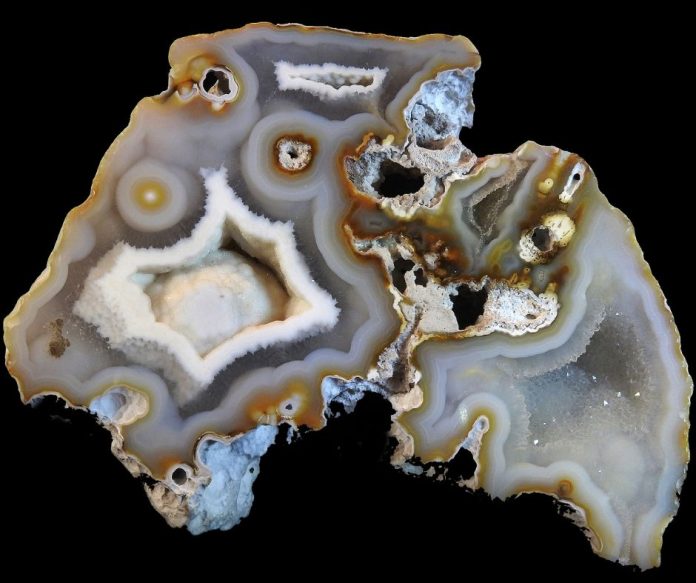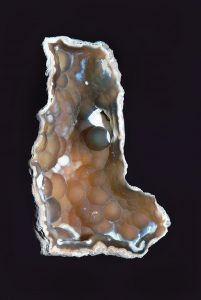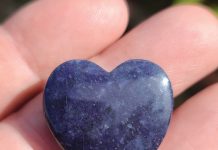
Ancient coral reefs off the western coast of central and south Florida must have been beautiful when living. Now, agatized coral geodes bring that beauty to the present.
How Agatized Coral Formed
Florida agatized corals are the skeletal remains of colonial animals, known as anthozoans, that died 25 to 38 million years ago. The actual skeletal structures are very easy to see in some specimens and can be used to identify the coral species.

The skeletons consist of limestone (CaCO3 ) and the coral becomes agatized when the coral voids are filled with silica-rich water and the limestone is replaced by chalcedony quartz (SiO2 ) and common opal.
Chalcedony that is translucent and colored is called agate.
The replacement process takes millions of years and results in what geologists refer to as a pseudomorph –a crystal consisting of one mineral, but having the form of another which it has replaced. Occasionally, very small clear visible quartz crystals will form after the chalcedony layer; but, it is the richly colorful agate layer that we find so attractive.
Is Agatized Coral a Geode?
As far as geodes go, these wonders of an ancient ocean are atypical. While some are the round shape we generally see in most geodes, many have shapes that vary.
Some have questioned whether these specimens should even be considered geodes, however, most geologists today, including June Zeitner and Brad Cross in Geodes: Nature’s Treasures, feel they do fit the criteria for being a geode.
How to Collect
I field-collected Tampa Bay coral in Hillsboro Bay in 1964 and as far as collecting goes it was not a pleasant experience!

I waded out into the bay barefoot and stirred up the mucky bottom with my feet. Occasionally, I would feel something solid and would reach down and bring it up out of the slimy mass on the bottom. Most times it was just an ordinary rock.
The few pieces of coral I found were all very small. I was quite disappointed until I returned home, cleaned the pieces up, and carefully cut them on my lapidary diamond saw. It was then that I realized the allure that these specimens hold for collectors.
There, in a specimen one and a quarter inches across, was an array of swirls of red, blue, black, orange and white that was just stunning!
Agatized Coral History
Archaeologists have found tools, knives, and weapon points fashioned from agatized coral dating back to 5,000 B.C. The more recent discoveries date back to the 1840s when the coral was found at Ballast Point in the Hillsboro Bay area. Hillsboro Bay is part of the Tampa Bay complex and hence the referral to coral found in this area as Tampa Bay coral.

Ballast Point has an interesting history related to the coral. Sailing ships carrying goods between the port of Tampa and Europe would use the coral as ballast to adjust the depth of their hulls.
During the early 1900s, there was an intense rivalry between young men living in Ballast Point and young men living in Port Tampa. The rivalry was over the affection of the Ballast Point young ladies. The Ballast
Point boys would collect a large supply of the most round “geode rocks” to use as ammunition to repel the Port Tampa boys.
The Port Tampa boys not having access to the geodes would throw large chunks of coal.
Most times geodes triumphed over coal!
Collecting Agatized Coral
For many years since its discovery, Tampa Bay coral was the best known and most widely field-collected of the Florida agatized corals. Collecting opportunities are now limited as most of the area has been developed. Construction areas provide some of the best places to collect, but be sure to ask permission first.

The other main areas where Florida agatized coral is found are in the Withlacoochee/Suwannee riverbeds along the Florida Georgia State line and the Econfina River area north of Perry, Florida. Currently, Withlacoochee River coral is the best field collecting choice.
Collecting is usually done by diving using a snorkel or aqualung and requires a boat.
Coral Colors
Tampa Bay geodes are notable for their wide array of colors that include black,yellow, honey brown, red and blue. The blue chalcedony is spectacular and may appear with swirls of yellow and red in the same geode.
The formation of drusy quartz is more common in Withlacoochee coral. Drusy quartz crystals are very tiny crystals that form on top of the chalcedony and give a sparkly appearance to the inner surface of the geode. The appearance of Withlacoochee coral is different from the Tampa Bay corals, but small fragments can be foolers.
References to Econfina River coral are not commonly found these days and I only have two specimens in my collection.
Econfina agatized corals are noteworthy as they frequently show distinct banding in the agate.
State Fame

In 1979, Florida agatized coral was designated by the Florida Legislature as the official state stone. Besides being displayed by individuals and museums in their collections, the coral has lapidary uses.
This story about agatized coral previously appeared in Rock & Gem magazine. Click here to subscribe! Story and photos by Richard Gross.












